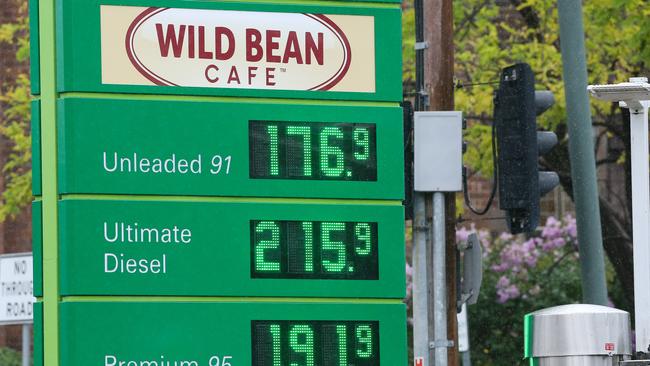RBA October minutes show a ‘low tolerance’ for a slower return to inflation target
With Michele Bullock at the helm, the central bank flags more rate hikes could be needed to curb stubbornly high inflation, amid rising fuel and house prices.
An increasingly hawkish Reserve Bank could be forced to lift interest rates next month as it warns against stubbornly high inflation amid rising petrol and house prices.
Economists say that minutes from first RBA meeting headed by new governor Michele Bullock, were “surprisingly hawkish” and alluded that a rate rise was now a strong chance if next week’s inflation numbers showed a further rebound.
The minutes showed that the RBA now had “low tolerance” for a slower return of inflation to its target band of 2-3 per cent. It also expressed concern that challenges in the Chinese economy could lead to slower growth in Australia if not contained, the local labour market had turned that rising house prices could boost consumption by more than forecasted.
After deciding to leave rates on hold for a fourth-consecutive month at 4.1 per cent, the minutes show that “some further tightening of policy may be required should inflation prove more persistent than expected”.
“The board has a low tolerance for a slower return of inflation to target than currently expected,” the minutes read.
“Whether or not a further increase in interest rates is required would, therefore, depend on the incoming data and how these alter the economic outlook and the evolving assessment of risks. Members reaffirmed their determination to return inflation to target within a reasonable time frame and their willingness to do what is necessary to achieve that outcome.”
The board also added a hawkish paragraph that while rising property values did not warrant tighter policy, the associated rise in household wealth could support consumption by more than currently assumed, especially if housing turnover picked up more quickly than expected.
“The rise in housing prices could also be a signal that the current policy stance was not as restrictive as had been assumed, although there was other evidence that monetary conditions were tight.”

Financial markets have priced in a 22 per cent chance of a rate hike when the RBA meets on Melbourne Cup day compared to a 6 per cent probability on Monday.
RateCity.com.au forecasts that a 25 basis point next month would see repayments on a $500,000 loan increase by $76 per month, $114 on a $750,000 mortgage and $152 each month for $1m owing to the bank.
Data from the Australian Bureau of Statistics showed that after several months of inflation slowing, the monthly CPI indicator was 5.2 per cent in the 12 months to August compared to 4.9 per cent in July.
The RBA said that higher fuel prices, driven by a 30 per cent jump in global oil prices, had “temporarily delayed” progress on reducing headline inflation. Nonetheless, it said that inflation could continue to be down in the second half of 2023 compared to the first half.
ANZ head of Australian economics Adam Boyton said that the possibility of a November rate hike was now a live option following the release meeting minutes from the RBA.
“Our view is that a rate rise in November would require an uncomfortably high CPI print, possibly combined with some sign of strength in the labour market,” he said.
“Pending the upcoming labour market and inflation data, we continue to expect the cash rate to remain at 4.1 per cent. Risks of RBA action appear to be rising, however.”

J.P. Morgan Australia chief economist Ben Jarman said the tone in the RBA minutes was “somewhat more hawkish than we’ve seen for a few months.”
He said it’s “hard to see why the board would be feeling more twitchy now on the basis of very recent data, but notes that the case for another hike would be framed around the statement of monetary policy forecast revisions due at the November meeting.
“We have expected upward revisions to growth after the 2Q data, which imply a downward bias to unemployment, and so upward bias to inflation forecasts for 2024/25,” Mr Jarman said. “In a relatively close call, we still expect a hike at the November meeting, though this week’s labour market data will be important, as will CPI next week.”
Citi senior economist Faraz Syed said higher services inflation was likely the catalyst for the new hawkish addition around low tolerance — even without higher oil prices, the August monthly print saw a sticky services inflation profile, with prices rising across various discretionary services items such as recreation and culture.
The prospect of a rate hike in November saw the ASX 200 more than halve its intraday gain to end up by 0.4 per cent at 7056.10, while the dollar and bond yields rallied.
The central bank considered a 25 basis point increase to the cash rate earlier this month, but concluded that there had not been new information from economic data or financial markets to necessitate an adjustment.
It also noted that the labour market had reached a “turning point” as output growth had slowed and as a barrage of rate hike work their way further through the economy. It added that a slowdown in the Chinese economy remained a key risk to the global outlook.
The RBA mentioned that these observations meant that the two events could however bring inflation back to target quicker than expected.






To join the conversation, please log in. Don't have an account? Register
Join the conversation, you are commenting as Logout